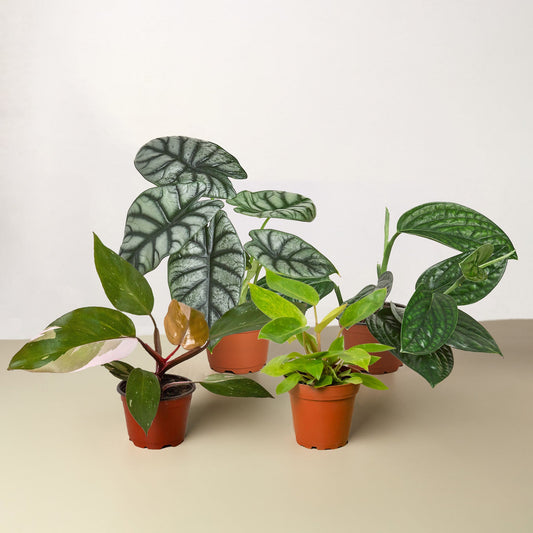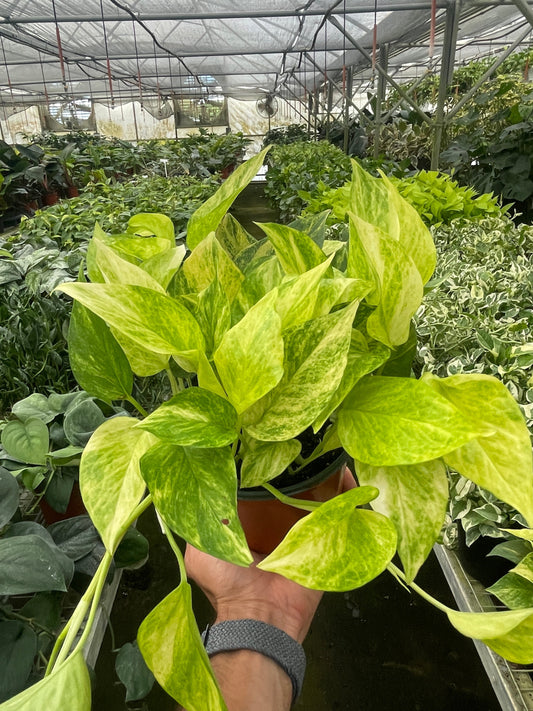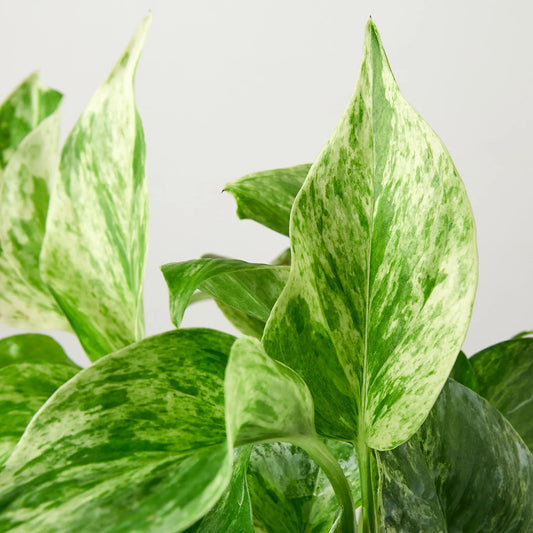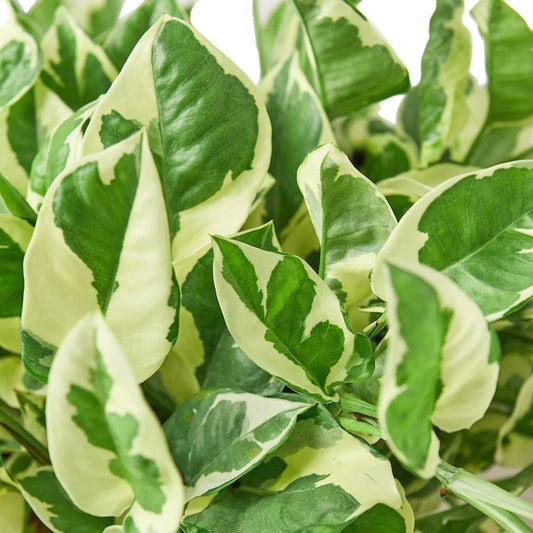Silver Philodendron Aerial Roots: Everything You Need to Know
Cafe Planta Team
If you're a fan of houseplants, you might have noticed a curious feature on your Silver Philodendron: aerial roots. These quirky little offshoots can be both intriguing and puzzling, especially if you're not sure what to do with them. But fear not—understanding aerial roots can enhance your plant-care skills and help your Silver Philodendron thrive.
In this article, we'll explore everything you need to know about Silver Philodendron aerial roots. From their purpose and care to how they can be used in your home decor, you're about to become an aerial root expert. So grab a cup of coffee, settle in, and let's talk about those mysterious roots.
What Are Aerial Roots?
First things first: what exactly are aerial roots? Simply put, aerial roots are roots that grow above the ground, unlike the typical roots that dig deep into the soil. These roots are a natural part of many plant species, including the Silver Philodendron. They can appear as thin, wiry strands or thicker, more robust offshoots, depending on the plant's age and environment.
Aerial roots serve several purposes, such as helping the plant anchor itself to surfaces, absorbing moisture from the air, and even assisting in nutrient uptake. In their native tropical environments, Silver Philodendrons use these roots to climb trees and other structures to access light and grow more efficiently. Pretty clever, right?
In a home setting, aerial roots might not have the same climbing opportunities, but they still play a crucial role in your plant's overall health. They're a sign that your plant is growing well and adapting to its surroundings. So, if you spot these roots, it's a thumbs-up from your Philodendron!
Why Do Silver Philodendrons Have Aerial Roots?
You might wonder why your Silver Philodendron is sprouting these above-ground roots in the first place. The answer lies in the plant's natural habitat. Originating from the rainforests of Central and South America, Silver Philodendrons have evolved to thrive in humid, tree-dense environments. Here, aerial roots are essential for survival.
In the wild, these roots allow the plant to climb and secure itself onto trees. This climbing ability helps the plant reach sunlight, which is often limited on the forest floor. Additionally, aerial roots can capture moisture from the humid air, providing the plant with an extra water source during dry spells.
In your home, while the conditions are quite different from a rainforest, aerial roots still contribute to your plant's well-being. They indicate that your Philodendron is healthy and actively growing. Plus, they can absorb moisture from the air, which is particularly helpful if you live in a dry climate.
In essence, aerial roots are a testament to your plant's adaptability and resilience. They're a natural part of its growth cycle and show that your Silver Philodendron is doing just fine in its indoor environment.
Caring for Aerial Roots
Now that you know what aerial roots are and why they exist, it's time to learn how to care for them. The good news is that these roots are generally low-maintenance. However, there are a few things you can do to ensure they remain healthy and beneficial for your plant.
Here are some tips for caring for your Silver Philodendron's aerial roots:
- Humidity: Since aerial roots absorb moisture from the air, maintaining a humid environment can help them thrive. Consider using a humidifier or placing a tray of water near your plant to increase humidity levels.
- Misting: If your home is particularly dry, mist the aerial roots with water a few times a week. This can help keep them hydrated and functioning properly.
- Avoid Cutting: While it might be tempting to trim aerial roots for aesthetic reasons, it's generally best to leave them intact. Cutting them can hinder your plant's ability to absorb moisture and nutrients.
- Support: If your Philodendron is using its aerial roots to climb, consider providing a support structure, like a moss pole or trellis, to encourage healthy growth.
By following these simple care tips, you'll help your Silver Philodendron's aerial roots remain healthy and functional, contributing to your plant's overall vitality.
Can You Propagate Philodendrons Using Aerial Roots?
One of the exciting possibilities with aerial roots is using them for propagation. If you're looking to expand your plant collection or share your Silver Philodendron with friends, these roots can be a helpful tool in the propagation process.
Here's a step-by-step guide to propagating your Philodendron using aerial roots:
- Identify a healthy stem with aerial roots. Look for a section of the plant that has at least one or two strong aerial roots and a few leaves.
- Using clean, sharp scissors or pruning shears, cut the stem just below the aerial roots. Make sure to include a leaf node, as this is where new roots will form.
- Place the cut stem in a glass of water, ensuring the aerial roots are submerged. Place the glass in a bright, indirect light location.
- Change the water every few days to prevent bacterial growth and encourage healthy root development.
- Once the roots have grown a few inches long, usually within a few weeks, you can plant the new cutting in soil. Use a well-draining potting mix to give your new Philodendron the best start.
Using aerial roots for propagation is a fun and rewarding way to grow your plant collection. Plus, it's a great way to share your love of Silver Philodendrons with fellow plant people.
Incorporating Aerial Roots into Home Decor
While aerial roots are functional, they can also add a unique aesthetic to your home decor. Embracing these roots as part of your plant's natural beauty can enhance the overall look of your indoor garden.
Here are some creative ways to incorporate aerial roots into your home decor:
- Natural Art: Let the aerial roots dangle freely from a hanging planter, creating a natural and artistic effect. This works especially well in spaces with high ceilings.
- Climbing Feature: Use a moss pole or trellis to encourage your Philodendron to climb, showcasing its aerial roots as part of a living wall or vertical garden.
- Vessel Displays: Place cuttings with aerial roots in clear glass vessels filled with water. This allows you to display the roots while they grow, adding an interesting visual element to your decor.
- Group Plantings: Combine your Silver Philodendron with other plants in a large pot, allowing the aerial roots to weave among the foliage for a lush, layered look.
By embracing the natural beauty of aerial roots, you can create a unique and visually striking plant display that complements your interior style.
Common Questions About Aerial Roots
As with any plant feature, you may have questions about aerial roots and their care. Here are some common queries and their answers to help you better understand and care for your Silver Philodendron.
Do Aerial Roots Need to Be Buried in Soil?
Not necessarily. Aerial roots are adapted to grow above ground, so they don't need to be buried in soil. However, if you prefer a tidier look, you can gently guide them into the soil or wrap them around a moss pole. Just remember that they can absorb moisture from the air, so keeping them exposed isn't a problem.
Why Are My Aerial Roots Drying Out?
If you notice your aerial roots drying out, it could be due to low humidity or insufficient watering. Try increasing the humidity around your plant by misting the roots or using a humidifier. Also, check that your plant is getting enough water, as this can affect the health of the aerial roots.
Can Aerial Roots Damage Surfaces?
In most cases, aerial roots won't damage surfaces like walls or furniture. However, if they're left to attach to porous surfaces like painted walls, they could leave marks or become difficult to remove. To prevent this, use a support structure like a moss pole to direct the roots away from surfaces you want to protect.
These answers should ease any concerns you have about aerial roots, helping you to confidently care for your Silver Philodendron.
Identifying Issues with Aerial Roots
While aerial roots are generally a sign of a healthy plant, they can sometimes indicate underlying issues if they appear unhealthy. Keep an eye out for any changes in the appearance of your plant's aerial roots, as these can signal a need for intervention.
Here are some common issues to watch for:
- Discoloration: If the aerial roots turn brown or black, it may be a sign of rot due to overwatering or poor air circulation. Ensure your plant has adequate drainage and is not sitting in waterlogged soil.
- Dryness: Extremely dry or brittle aerial roots could indicate low humidity or insufficient watering. Increase humidity levels and consider misting the roots more frequently.
- Limited Growth: If you notice that the aerial roots aren't growing as expected, it could be due to insufficient light or nutrients. Make sure your plant is receiving adequate light and consider feeding it with a balanced houseplant fertilizer.
By staying vigilant and addressing these issues promptly, you can maintain the health and vitality of your Silver Philodendron's aerial roots.
Aerial Roots and Plant Health
Aerial roots are more than just an interesting feature—they're an important indicator of your plant's health. When these roots are thriving, it's a good sign that your Silver Philodendron is happy and well-cared for. But what exactly do healthy aerial roots look like?
Healthy aerial roots should be:
- Firm and Flexible: They should feel firm to the touch but still have some flexibility, indicating that they're hydrated and healthy.
- Consistent in Color: Aerial roots should be a consistent color, typically green or a light brown, depending on the plant's age and environment.
- Actively Growing: If you notice new aerial roots forming or existing ones growing longer, it's a sign that your plant is thriving.
If your aerial roots meet these criteria, you're doing a great job caring for your plant. Keep up the good work, and your Silver Philodendron will continue to flourish.
The Unique Charm of Silver Philodendron Aerial Roots
At the end of the day, aerial roots are part of what makes the Silver Philodendron such a unique and charming houseplant. These roots add character and personality to your plant, making it stand out in your indoor garden. Embracing their unique qualities can enhance your appreciation for this beautiful plant.
Whether you're using aerial roots for propagation, incorporating them into your home decor, or simply marveling at their natural beauty, they offer endless opportunities for creativity and connection with your plant. So, the next time you spot an aerial root, take a moment to appreciate its role in your plant's life and the joy it brings to your home.
Final Thoughts
We've covered everything from the purpose and care of Silver Philodendron aerial roots to their role in propagation and home decor. By understanding and embracing these unique roots, you can enhance your plant-care skills and enjoy the full beauty of your Silver Philodendron.
At Cafe Planta, we love helping fellow plant lovers care for their green companions. If you have any questions about your houseplants, feel free to email us or reach out on Instagram. We're excited to share our passion for plants and help you create a beautiful, thriving collection in your home!



















